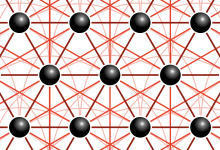HPC User Report from S. Fey (Chair of Theoretical Physics I)
Quantum criticality of two-dimensional quantum magnets with long-range interactions
We investigate the criticality and universality classes of the frustrated and unfrustrated Ising model with long-range interactions in a transverse field. Today, very little is known for these systems in two dimensions, so that we aim to close this gap with our studies.
Motivation and problem definition
There are many areas in which long-range interactions become important, although in most studies they have been neglected so far. There are some results for the quantum critical points and universality classes of a one-dimensional quantum Ising chain. However, in two dimension almost nothing is known to date.
Our goal is to shed some light on the question where the phase transition between the polarized and the ordered Z2-symmetry-broken phase happens and what the corresponding universality class is – both for a square and triangular lattice in two dimensions.
Methods and codes
 In a new approach we combine a inked cluster expansion method (PCUT) using “white graphs” with classical Monte Carlo calculations to obtain a high-order series of the one-quasiparticle gap. Afterwards Pade and DLog Pade extrapolations allow the extension of the sum’s convergence radius and an extraction of quantum-critical points and exponents.
In a new approach we combine a inked cluster expansion method (PCUT) using “white graphs” with classical Monte Carlo calculations to obtain a high-order series of the one-quasiparticle gap. Afterwards Pade and DLog Pade extrapolations allow the extension of the sum’s convergence radius and an extraction of quantum-critical points and exponents.
The series expansion yields a large amount of high-dimensional infinite sums which need to be evaluated to obtain numerical data about the phase transition. These sums are evaluated using classical Markov-chain Monte Carlo integration where these sums can be computed for different seeds in parallel.
For all calculations internal codes are used.
Results
For the ferromagnetic model on the square and triangular lattice there are three different regimes: The regime around the nearest-neighbor limit shows the nearest-neighbor universality class with the corresponding exponent. For very long-range interactions a mean-field exponent is obtained. In between those areas the critical exponent z*\nu varies continuously when tuning the
range of the interaction.
For an antiferromagnetic interaction we find a different behavior. For the complete parameter range the phase transition seems to stay in the nearest-neighbor universality class.
Outreach
The work has been published in PhysRevLett (https://doi.org/10.1103/PhysRevLett.122.017203).
The topic of the project is also a part of the application for an SFB.
Researcher’s Bio and Affiliation
Sebastian Fey is currently affiliated with Prof. Dr. Kai P. Schmidt at “Lehrstuhl für Theoretische Physik I” at the FAU Erlangen-Nürnberg. He studied physics at TU Dortmund and got his Master’s degree on the topic “Field-driven Instabilities of the Non-Abelian Topological Phase in the Kitaev Model”.
